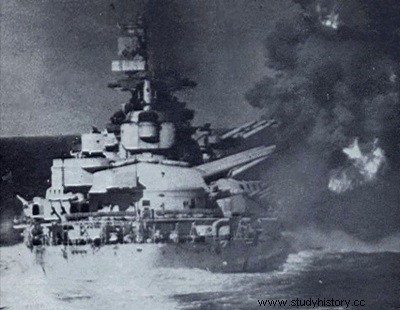
At this crucial moment, aircraft based aboard the aircraft carrier Formidable attacked the Italians, who repelled them without either of the two adversaries suffering the slightest damage. The Vittorio Veneto moved away, but was chased by Cunningham. Five torpedo planes from Formidable attacked her again, while at 3:30 p.m. the Italian battleship was also under attack from high altitudes by R.A.F. The latter did not score a hit, but occupied the D.C.A., which allowed the Formidable's aircraft to arrive skimming the waves.
The Vittorio Veneto changed her course to present her stern — the smallest possible target — to the enemy. From then on, the Italian fleet concentrated its fire on the torpedo planes which arrived in line. Lieutenant Dalyell-Stead, who was leading the attack, released his torpedo, then was taken down. His craft sank into the waves before the torpedo had even reached the Vittorio Veneto. She hit it on the port side, opening a breach through which 4,000 tons of water rushed. set course for Taranto at a speed of first 10 knots and then 20 knots, which meant that he was still fast enough not to be overtaken by the British before nightfall.
At 7.30 pm, about half an hour after sunset, six 'Albacore' and four 'Swordfish' attacked the Italian cruisers and destroyers, now grouped in five columns around the Vittorio Veneto. The Italian D.C.A. was very precise and the spotlights blinding. The planes had to break their flight formation but individually continued to attack. One torpedoed the 10,000 ton cruiser Pola. At the time, it could not be identified with certainty, and Cunningham hoped for some time that it was the Vittorio Veneto.
The pursuit continued at night. The British fleet had never fought like this since the Battle of Jutland, twenty-five years earlier, and despite constant drills in the previous years, no one was sure that all would go well. Cunningham, however, preferred, whatever the risks, to fight by night to the prospect of clashing with the Luftwaffe the next morning.
The British cruiser Ajax, one of the few ships to that time, to have a radar, spotted a large immobilized building. Cunningham rushed to the scene, still hoping it was the Vittorio Veneto, and as he went. he saw three other ships in the night. two large and one small, cutting through the waters in front of the British buildings. Formidable withdrew as a carrier was of no use in close night combat, but Warspite, Valiant and 1.e Barham opened fire from the ridiculously short range of 4,000 meters, while the Searchlights from destroyer Greyhound illuminated the enemy. At 10:28 p.m., the battleships in turn unmasked their searchlights, and a first broadside of six 381 mm shells, fired by the Warspite, reached the objective. Others followed-
rent “You could see whole turrets and
a lot of other heavy debris spinning through the air and sinking into the sea; in no time the ships themselves were blazing like torches, from prow to stern,” Cunningham later wrote. That target was Fiume.
The Italians had been attacked by surprise; they were unaware of the presence of large English buildings in the vicinity. Furthermore, without searchlights, they could not successfully maneuver their 203 mm guns at night. Three destroyers that accompanied the Italian cruisers steered to attack the British fleet, which moved away. The fight had lasted four and a half minutes, and the Fiume and the Zara were sinking when the English broke contact.
